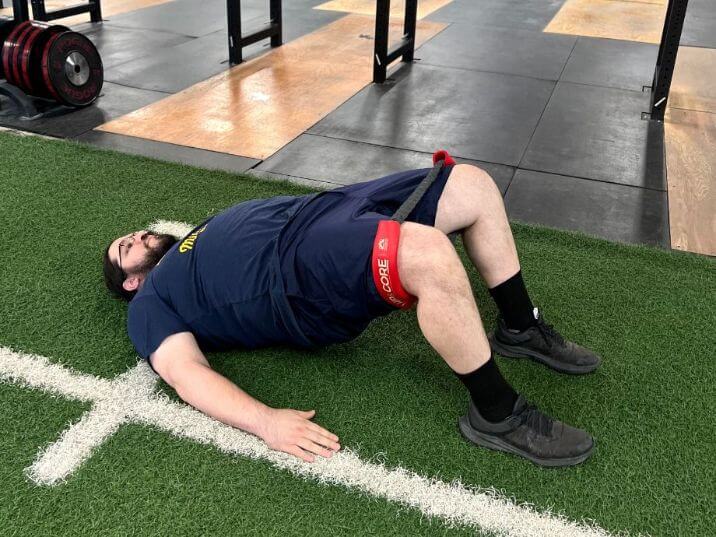We test and review fitness products based on an independent, multi-point methodology. If you use our links to purchase something, we may earn a commission. Read our disclosures.
You won’t have to search high and low to find someone in your gym who squats or deadlifts on the reg, but what about the hip thrust? This hamstring-hitting, glute-blasting barbell exercise makes a great addition to any lower body workout.
A 2019 systematic review published in the Journal of Sports Science & Medicine1 stated that the hip thrust exercise “presents greater activation of the hip extensor muscles compared to more conventional exercises.”
According to Amanda Capritto, CPT and GGR Senior Staff Writer, strong hip extensors translate to better biomechanics, specifically when moving the body upward and/or forward.
“You’ll find activities like running, sprinting, jumping, and stair climbing easier if you’re using exercises like the hip thrust to strengthen your extensors,” says Amanda.
So, if you’re ready to improve lower body strength and get those gains, check out our hip thrust workout. We’re covering how to do the barbell hip thrust, providing trainer tips for proper form, calling out common mistakes to avoid, and recommending a few accessories to make the move more manageable, too.
RELATED: Glute Exercises At Home
How To Do Hip Thrusts
- Load a barbell, then place it on the floor alongside a weight bench.
- Sit down with your back to the bench and roll the bar over your legs to the crease of your hips. Keep both feet planted firmly on the floor with your knees bent.
- Drive your feet into the floor and thrust your hips into the air, lifting the barbell, until your upper body and hips form a straight line with your shoulders resting on the bench. Squeeze your glutes.
- Control your hips so that they slowly return to the starting position.
- Repeat as needed.
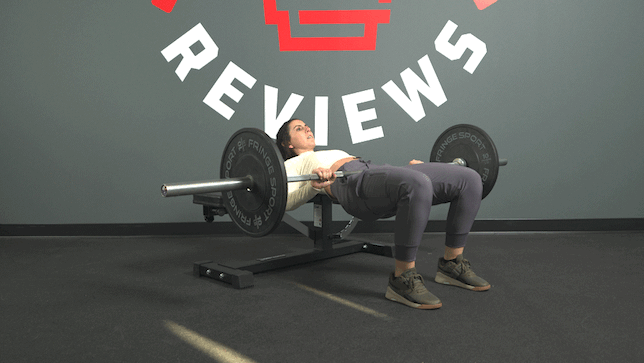
Trainer Tips for Form
The range of motion is not huge for the hip thrust exercise, but you’ll still get muscle activation in the gluteus maximus, gluteus medius, hamstrings, quads, hip extensors, hip adductors, and abdominal muscles.
Amanda Capritto provides pointers on proper form so you can get gains in these key areas while keeping your risk of injury minimal.
Maintain a Neutral Spine
The hip thrust exercise, when performed correctly, is an effective way to strengthen the lower body muscles without as much stress on the lower back2 as standing exercises like the deadlift.
If you’re arching your back excessively during the thrust, however, you’ll wind up taking the spine out of alignment, increasing your risk of back pains, strains, and herniations.
“Focus on maintaining a flat back throughout each phase of the movement,” says Amanda. “You want to form a straight line from your upper body to your knees in the peak position.”
Keep Your Gaze Forward
Speaking of proper alignment, your neck is crucial in regards to achieving that goal.
“We have a tendency to look down during exercises like the hip thrust,” says Amanda, “but looking at your legs or the barbell instead of straight ahead curves the neck and increases the stress to your neck.”
Keep those eyes dead ahead during your reps. If you’re a beginner and you’re not sure about your form, try filming the set and viewing it once the weight has been safely returned to the floor, or work with a qualified training partner or personal trainer to provide cues as you work.
Practice Glute Activation
According to a 2020 study published in the Journal of Sports Science & Medicine3, the hip thrust ranks among the best exercises for glute activation, making it one of the best exercises to include in your glute strength training regimen.
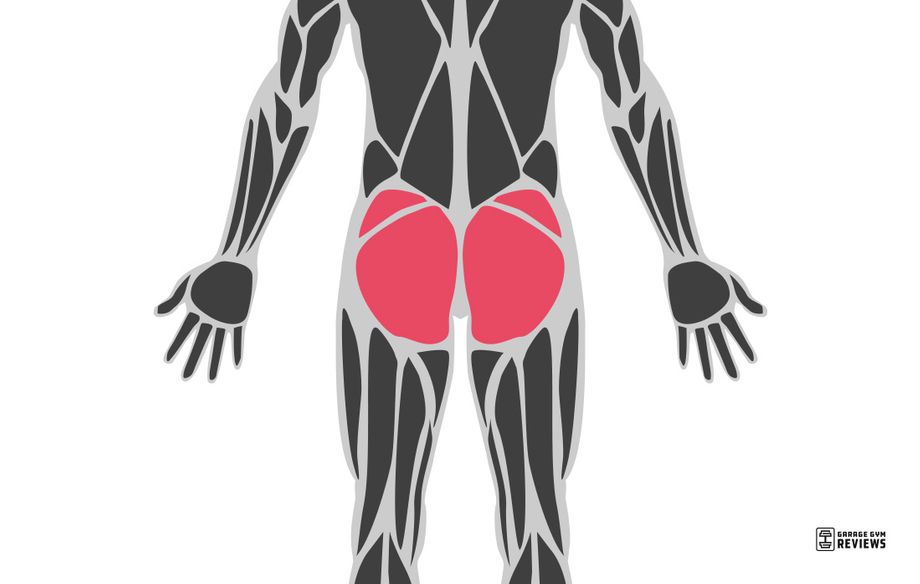
Unfortunately, some fitness enthusiasts diminish this effect by overly relying on the quadriceps to produce the force needed to move the bar.
“To get the most glute activation, you’ll want to focus on them during the eccentric phase of the movement,” says Amanda. “When you thrust, really focus on squeezing the glutes and using them to produce the force needed to move that barbell.”
Shoulders Collapsing
When in the proper position, your upper back and shoulders will stay in contact with the bench. You want those shoulder blades pinched to help hold tension while you’re moving the weight.
“If your shoulders are relaxing during the exercise,” says Amanda, “one of two things has likely happened. Either you’ve shrugged your shoulders, which places strain on the neck, or you’ve lost tension in the core, putting strain on the lower back.”
Neither of these scenarios are ideal positioning, so check in with your form as you move to ensure you’re keeping the shoulder blades squeezed together and in contact with the bench.
Common Hip Thrust Mistakes
Now that we know what to do, let’s talk a little about what not to do.
Here are the most common mistakes made when learning or performing the hip thrust exercise.
Improper Foot Positioning
If we’re going to build strength in our glute muscles using the hip thrust, we have to make sure we’re getting a full range of motion and promoting proper biomechanics from start to finish.
RELATED: Resistance Band Exercises for Glutes
That’s hard to do if you don’t have your literal footing.
“Your feet should be slightly in front of your knees,” says Amanda. “Keeping your feet too close puts strain on the knee joint, which could lead to injury, while keeping your feet too far away shifts the emphasis off the glutes and onto the hamstrings.”
Arching the Back
The prospect of having strong glutes is so exciting, it’s easy to get carried away!
You’ll want to get that enthusiasm in check though, because overthrusting will result in an arched back, ruining your perfect postural alignment and placing an undue burden on the back.
Tucking the Tailbone Too Much
We praise the hip thrust for its superior activation of the gluteal muscles, but when exactly are we getting the most activation during the movement?
According to Amanda, it’s the end position, specifically when you’ve achieved full hip extension.
“Trainers will commonly instruct clients to tuck their tailbone once in this position,” says Amanda. “But, remember, everything in moderation. Tucking too much takes your body out of alignment, which is counterintuitive.”
As with everything, practice moderation. Tuck your tailbone until you feel the glutes activate, then hold it there and clench those cheeks!
Moving Too Quickly
You might feel like a beast flying through your hip thrusts, but you’re only cheating yourself out of that ever-essential time under tension. After all, that’s what’s going to lead to the gains—the time under tension, not the reps themselves!
Plus, moving too quickly causes you to consciously or unconsciously take shortcuts with the movement pattern, which could at best diminish the exercise’s effectiveness and cause an injury in the worst case scenarios.
Do yourself a favor and take your time on each rep to ensure you’re using the right muscle groups throughout each phase of the movement.
Hip Thrust Variations
Mastered the regular old barbell hip thrust?
No worries; here are a few hip thrust variations to sprinkle some variety into your next sesh!
Dumbbell Hip Thrust
Lugging a barbell to the bench is exhausting and, while some folks would call that a built-in warm up for the set, some people prefer the convenience of dumbbells instead.
The upside of using dumbbells is the convenience of bringing one handheld free weight to your station instead of a big ol’ barbell. The downside, however, is that you won’t be able to move nearly as much weight using dumbbells.
To perform the dumbbell hip thrust, select your desired weight, get into the hip thrust position, hold the dumbbell in your lap with both hands so it doesn’t slide away, and get to thrusting!
RELATED: Best Dumbbells
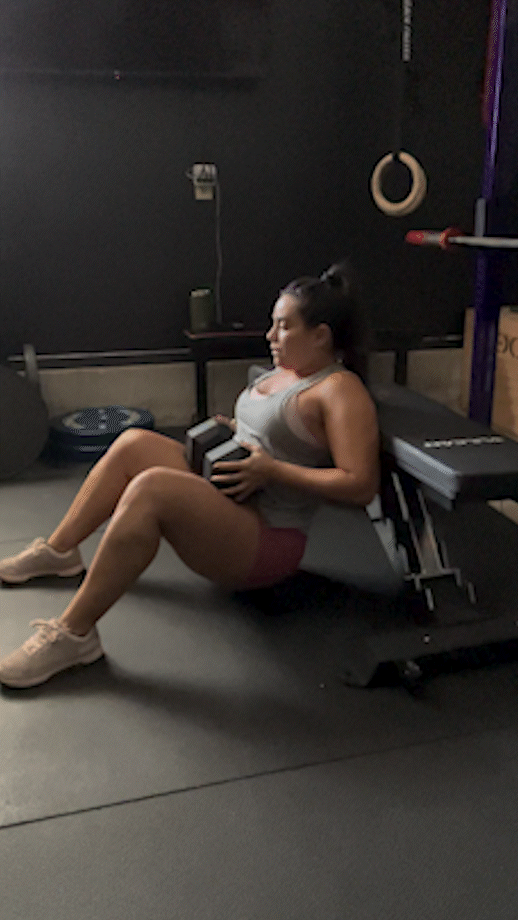
Single-Leg Hip Thrust
Looking to correct muscular imbalances?
You can, in fact, perform the hip thrust one leg at a time for this precise purpose.
Of course, taking one foot out of the equation places new challenges to your balance, but that’ll result in improved balance and stability as you gain familiarity with the movement.
To manage this new stimulus, we recommend trying the single-leg hip thrust with just your body weight at first, then add in weight later once you’re feeling more comfortable.
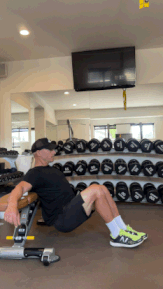
Glute Bridges
No bench? No problem!
Glute bridges, performed from the floor, provide similar activation to the glute muscles, as well as other lower body muscles and your core.
Here are steps on how to perform the glute bridge with great form:
- Lie supine on the mat with your knees bent and feet on the floor.
- Lift your butt off the floor by pushing your feet into the floor and driving your hips up.
- Squeeze your glutes before coming back down.
- Repeat as needed.
Glute bridges make a great dynamic movement to target your glute muscles, legs, and core, but it can also be converted into an effective isometric exercise if you prefer.
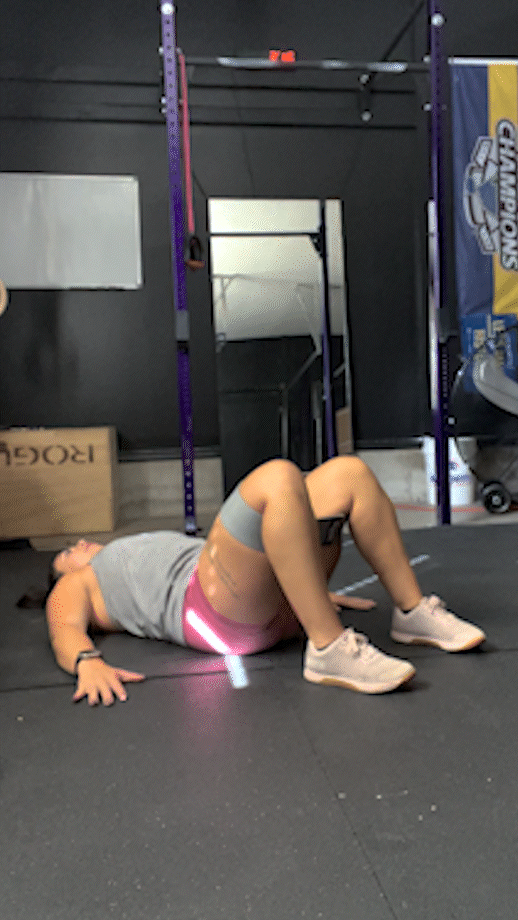
Single-Leg Glute Bridges
Switching your regular glute bridge for the single-leg version will force you to really exercise some lower body and core strength in order to control the movement and maintain balance throughout the range of motion.
Once lying on the mat, lift one leg into the air and hold it there as you get in your reps. Then, bring it down, switch sides, and repeat.
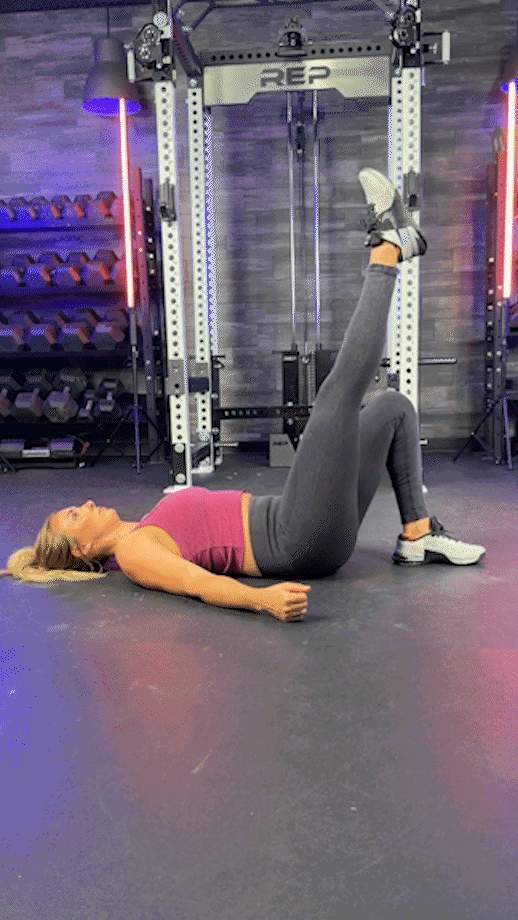
Hip Thrusts with Resistance Bands
According to a 2019 systematic review published in SAGE Open Medicine4, “elastic resistance training is able to promote similar strength gains to conventional resistance training.”
So, you 100% do not need free weights to get a great hip thrust workout, so long as you have a great set of resistance bands on hand.
RELATED: Best Resistance Bands for Glutes
Here’s how to perform the banded hip thrust with good form:
- Slide a resistance band around your legs and position it right above your knees.
- Get into your hip thrust position, brace your core, and drive your pelvis upward so that your quads, core, and upper body form a straight line that’s parallel with the floor.
- Squeeze the glutes, then release and return to the starting position.
- Repeat as needed.

Useful Hip Thrust Equipment and Accessories
Do you have what you need to do barbell hip thrusts in your home gym?
Here’s a quick checklist of our favorite hip thrust accessories, so you can build glute strength comfortably and in style!
Barbell Pad
Some folks love talking about grit and think a heavy barbell digging into you builds character. That’s fine if that’s what you’re into, but it’s definitely not a requisite.
Do yourself a favor and pick up a high-quality barbell pad, like the AbMat Hip Thrust Pad, so you don’t have to tune out the feeling of hard steel bruising you while you should be focused on squeezing your glutes!
Padded Bench
You need a sturdy, elevated surface for your upper body to achieve proper positioning.
Might as well make it the best of the best and grab yourself the Tru Grit Flat Utility Weight Bench. This bench not only provides the perfect place for hip thrusts, it’s also fantastic for bench presses, triceps dips, and other essential flat bench exercises.
Exercise Mat
To be fair, you’re not really doing a hip thrust anymore if you’re on the floor. Now, you’re doing a glute bridge.
But whether you’re doing a glute bridge, plank, dead bug, or even Pilates, a high-quality exercise mat makes a huge difference.
Given how lightweight, portable, and inexpensive they are, there’s really no excuse for not having at least one great mat in your home gym.
FAQs: Hip Thrust Workout
What muscles do hip thrusts build?
Hip thrusts predominantly build the gluteus maximus, medius, and minimus, as well as the hamstrings, but you’ll also feel it in your quadriceps, hip extensors, hip adductors, and core.
How many hip thrusts should I do with weights?
As with any exercise, you’ll want to cater the amount of weight you’re lifting, as well as the number of sets and reps, to what your specific fitness goals are.
Generally speaking, do less reps, between three and five, for heavier weights to promote strength gains, while higher reps, between 10 and 20 reps, work best with lighter weights to promote hypertrophy and muscular endurance.
When in doubt, consult a certified personal trainer or other qualified fitness professional.
Are hip thrusts better than squats?
Barbell hip thrusts provide activation in a good number of muscle groups throughout the lower body, but that number pales in comparison to what muscles a back squat works.
Back squats provide superior activation in the posterior chain muscles, like the lower back, quads, hamstrings, and calves, and upper body muscles, like the shoulders, chest, and core.
Squats target the glutes, too, but that’s where hip thrusts get an edge. According to a 2021 study published in the Journal of Strength and Conditioning Research5, “EMG activity in the gluteus maximus [is] higher in the hip thrust than in the back squat.”
Both have their place in a well-crafted workout routine, but you’ll enjoy a wider array of perks from squatting than you will from doing hip thrusts.
Do hip thrusts make glutes bigger?
Absolutely. Hip thrusts provide loads of glute activation, so, combined with the right diet and rep scheme, you should definitely see an increase in glute muscle size and thickness from doing hip thrusts regularly.
References
1. Neto WK, Vieira TL, Gama EF. Barbell Hip Thrust, Muscular Activation and Performance: A Systematic Review. J Sports Sci Med. 2019;18(2):198-206. Published 2019 Jun 1.
2. Otsuka M, Honjo T, Nagano A, Isaka T. Kinetics in lumbosacral and lower-limb joints of sprinters during barbell hip thrust compared to deadlift and back squat. PLoS One. 2021;16(7):e0251418. Published 2021 Jul 1. doi:10.1371/journal.pone.0251418
3. Neto WK, Soares EG, Vieira TL, et al. Gluteus Maximus Activation during Common Strength and Hypertrophy Exercises: A Systematic Review. J Sports Sci Med. 2020;19(1):195-203. Published 2020 Feb 24.
4. Lopes JSS, Machado AF, Micheletti JK, de Almeida AC, Cavina AP, Pastre CM. Effects of training with elastic resistance versus conventional resistance on muscular strength: A systematic review and meta-analysis [published correction appears in SAGE Open Med. 2020 Sep 9;8:2050312120961220]. SAGE Open Med. 2019;7:2050312119831116. Published 2019 Feb 19. doi:10.1177/2050312119831116
5. Williams MJ, Gibson NV, Sorbie GG, Ugbolue UC, Brouner J, Easton C. Activation of the Gluteus Maximus During Performance of the Back Squat, Split Squat, and Barbell Hip Thrust and the Relationship With Maximal Sprinting. J Strength Cond Res. 2021;35(1):16-24. doi:10.1519/JSC.0000000000002651
Further reading

A certified personal trainer reviews this air compression massage device designed to optimize your post-workout recovery in our Normatec Elite review. Read more

Want to know which power rack attachments work with your setup? Check out our expert guide with top brands like Rogue, REP Fitness, and Titan. Read more

If you’re wondering, "What muscles do burpees work?" look no further. We list the muscles activated, and explain the benefits of doing this bodyweight exercise. Read more

Being in a calorie deficit means you’re burning more calories than you eat. It’s the only way to lose weight, but what are the other health implications? Read more

